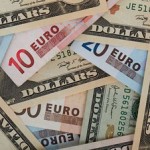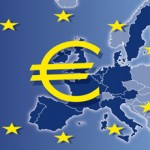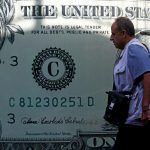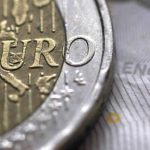Euro Projected to Weaken against the Dollar

For the Euro to move higher tapering the asset purchase programme must be mentioned at Thursday’s ECB meeting but also keep an eye out for the abolition of the ‘capital key.’
The Euro will probably weaken against the Dollar during the European Central Bank’s (ECB) rate meeting on Thursday, December 8, say Morgan Stanley in a briefing to clients ahead of the event.
The bank’s base-case scenario is for the ECB to announce an extension to its programme of asset purchases by another 6 months beyond the March expiry.
They also see a change to the criteria by which they decide which bonds are eligible for purchase.
“Our economist’s assumption is that the ECB will keep rates on hold at next week’s meeting but add a 6m extension to its QE purchase programme,” says Morgan Stanley’s Sheena Shah.
Morgan Stanley conclude that EMU front-end rates need to be pushed down more than those in the US to weaken EURUSD. “Simply extending purchases by 6 months would have limited impact on the EUR.”
Analysts expect EURUSD to fall based on the rate differential staying wide and ensuring a continuation of broad USD strength.
US yields continue on their upward trajectory as a result of a more inflationary outlook due to President-Elect Trump’s expected stimulus package, whilst rates in the Eurozone have no such stimulatory driver to help them higher.
The Fed is also expected to raise interest rates in December, in comparison, the first-rate hike from the ECB is not expected until 2020.
“The first hike is now 38 months away in 2020 instead of 60 months away as was priced at the end of October,” says Shah.
In a currency pair money tends to flow to the currency with the higher interest rates as international investors seek higher returns on their cash.
Talk of Tapering
One thing which would lead to a rise in the Euro is any hint that the central bank is considering tapering its asset purchases in the short-term.
“We believe the reaction of the EUR over the ECB meeting will ultimately depend on the probability of tapering in the next 12m. In particular, EURUSD will depend on the short end rate differential between EMU and the US,” says Shah.
However, from anecdotal evidence garnered by “speaking to clients” they do not expect asset purchases to be tapered in 2017.
The Euro would gain ground against the Dollar if the ECB decided not to extend asset purchases as that would, by default, suggest an end to QE in March 2017.
Other Possible Outcomes
Morgan Stanley’s base case scenario is that the ECB will extend its QE programme by 6 months.
However, this implies the Bank will have to relax the buying criteria for the programme, since there is unlikely to be adequate inventory for it carry on with purchases under the current strict criteria.
One thing the ECB could do is to relax the “Capital Key” which dictates the share of bonds bought from each country based on the size of that country’s economy.
This means the majority of bonds bought under the current Capital Key are German since it has the largest economy.
This has led to a lack of inventory as it has pushed up German bond prices and pushed down many of their yields into negative territory.
If the ECB chooses to do away with the Capital Key it would be bullish for the Euro, if it chose to allow purchases below the deposit rate it would be bearish for the Euro, according to Shah.
However, analyst Tomasz Wieladek at Barclays believes, “a removal of the capital key is highly unlikely, in our view, given the moral hazard implications”.
Another rule is that bonds must not yield below the ECB deposit rate of -0.4%, however, many German bonds now yield lower due to the Capital Key, thus a lack of inventory dogs the smooth running of the system.
A potential way of addressing the scarcity of German bunds, especially of short-duration bonds, would be by ‘enhancing the Bundesbank’s repo facilities’. “Any rise in short end rates as a result of reduced worries about bond availability would strengthen the EUR but we wouldn’t expect more than a 1% rise,” says Shah.
Another way to increase bond inventory for the scheme would be to remove the cap on issuers which currently stands at 50%.
This means the ECB can only buy a maximum of 50% of the issuance of a bond.
Shah says that an increase in the percentage available to the ECB would take the pressure of German bonds leading to a rise in the whole German Yield Curve:
“This approach would generally be bullish for the whole German bund curve. For EURUSD to fall we would need to see a larger decline in bund yields than US treasury yields, pushing down the yield differential. EURUSD is generally more sensitive to front end rates (2y) than long end rates (10y).
Morgan Stanley sees an increase in the share of corporate bonds in the buying mix as highly unlikely. Equally as unlikely is a cut in rates of 10 basis points.
An extension of the Bond programme beyond 6 months is also unlikely.
Cut in monthly purchases suggested
Morgan Stanley does not address the possibility of the monthly limit of 80bn bond purchases in the programme being cut alongside an extension of 6 months, as analyst Clara Leonard of BNP Paribas suggests:
“Our economists expect the December ECB to announce that it will prolong quantitative easing by six to nine months and scale back its asset purchases from EUR 80bn to EUR 60bn per month.
“We think this announcement will be moderately bullish for the EUR and do not expect a very large market reaction, as our rates team does not expect a significant rise in rates.”
Source: Pound Sterling





























